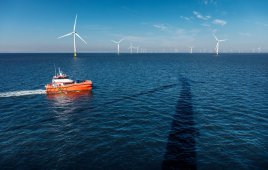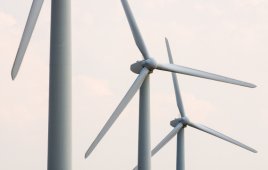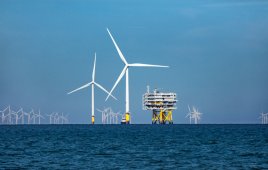A worn component can unexpectedly shut down a single turbine, but a flawed network can shut down the whole wind farm. Putting several best practices to work when designing or upgrading a wind-farm network can avoid such disasters.

Red Lion’s G3 operator interface panels provide HMI capability for PLCs, motor drives, and other communications-capable devices. These can drive productivity in industrial wind-farm environments through improved visibility, management, and control.
Wind farms generate a lot of data with regard to how well they are working and the attention individual turbines need. Most farms are deployed in remote locations so a reliable data network becomes critical for shaping successful maintenance plans and profitable operations. In the past few years, network designers have recognized several best practices for more efficient wind farms.
In a nutshell, the best network practices for maximum profitability include ensuring reliability, building redundancy into the network, planning for scalability, simplifying installations, and using advanced, proven management methods. This article expands on each of these and covers a few real-world deployment examples.
Plan for reliability
Reliability should be the cornerstone of a network to avoid unscheduled maintenance. It accounts for up to 75% of the total turbine-maintenance costs. Not only is it expensive to send a team of technicians to remote sites, it becomes even more costly when the parts they need are unavailable. While predictive and preventive maintenance can help proactively plan downtime that limits it to about four hours. Unplanned events can take up to 14 days or more.
When designing for reliability, it’s also important to realize that all networking devices are not created equal. Standard commercial-grade networking switches, for example, are not intended for extreme environments. They are intended for temperature-controlled spaces, and are ill equipped for temperature extremes and vibration levels common to a nacelle. The table Comparing commercial and industrial Ethernet switches shows the typical differences between both types of switches.
Building redundancy into the network
Redundancy in the network is the second best practice of designing effective wind farms. One of the single most frequent failures, power supplies, help make this point. When one fails, another should detect the power loss and pick up the slack. This is why dual power sources are essential.

In this sample network layout, depicting a nacelle and tower, the dual lines from slip rings and controls to industrial switches indicate redundancy and hence, built in reliability.
The illustration The network and controls in a nacelle, shows that network designers typically place a switch in the rotary hub to send signals through a slip ring into the nacelle. From there, sensors feed data into a switch that sends them down the tower to another switch. Redundant links in the tower are recommended so that if there is a point of failure in the nacelle, another path exists to get data out. Also, fiber-optic cable should be used because there is often electrical noise, EMI, in the nacelle, and towers reach up 100m and more.
Ring topologies are an excellent choice for redundancy between each switch in the network. Here’s why: If a line breaks in a linear topology, there is no way for data to reach central control and data stops going to other devices. But a ring network provides a redundant path.
One basic Ethernet rule states that loops are not allowed in the network. By design, when a switch receives a broadcast, it repeats the broadcast out of every port except the one it was received on. So, in a looped or ring environment, broadcasts are repeated forever creating what’s called a broadcast storm. The switch serving as the ring manager prevents this by blocking one of the paths in the ring. In addition, with Red Lion’s N-Ring technology, the ring manager dynamically configures the ring and blocks a segment of it to prevent a storm creating loop. The ring manager then regularly sends out Health Check Packets at a fast rate around the ring. When these packets make it back to the ring manager in the specified amount of time, the ring is intact and therefore healthy. However, if the ring is broken and the ring manager stops receiving the health check packets, the ring manager converts the ring to a backbone within ~30 milliseconds.
This is complemented with software features that let network managers examine the network to ensure it is working properly. What’s more, if there is a break, the software highlights the break point so maintenance crews know exactly where to look.
Planning for scalability
Ethernet is an appropriate choice for wind applications because switches provide a scalable solution that is easily integrated into the network. In addition, fiber optic cabling works seamlessly with Ethernet because of the distance it can cover. When using single-mode fiber, cabling can run as far as 80 km. This provides the distance needed to cover the vast expanse of a wind farm coupled with the added benefit of EMI immunity.

Wind farms require high-speed, high-capacity networks that provide real-time access to information. Red Lion’s industrial Ethernet switches deliver rugged reliability and high performance in wind farm environments.
Another consideration for remote wind farms: choose an industrial switch designed for simple installation and configuration. When the right selection is made, it is unnecessary to have a certified network engineer deal with network idiosyncrasies and replacing faulty network switches. A good industrial switch minimizes configuration challenges through plug-and-play capabilities. For example, many switches have auto configuration features that let them negotiate port speeds and detect cable crossover in the case of CAT5 copper cable.
Another feature allows automatic setup for communication with the process control device. Other considerations for advanced management should include:
- Automatic IGMP (Internet Group Management Protocol) configuration
- Quality of Service (QoS), and
- VLANs
Using advanced tools such as these can minimize, and in many cases, eliminate complicated setup. You want maintenance people to focus on the turbines, not the configuration and health of the network.
Simplified installations

A small wind farm might show a similar arrangement of switches. Ethernet and fiber optic cables ensure rapid transmission for a mountain of information.
Switch manufacturers offer several useful features. Take the N-Ring configuration discussed above for example. Once the ring manager is set up, it automatically sets up and configures the rest of the ring devices.
In addition, it is important to make sure all deployed switches have backup and restore capabilities. This way, in the case of a failure, configuration data can be easily pulled from the switch before replacing it with a new one. This helps simplify maintenance and keep the network running efficiently.
Another feature: Automatic change detection in the network. When a new PLC is installed, for instance, the port speed changes and will be automatically detected.
As you’d expect, different wind farm networks use different products. Some use unmanaged switches, unmanaged switches with monitoring capability, and managed switches. There are many ways to build a network. However, we advise the use of managed switches because of the capability of rings and diagnostics. Managed switches provide advanced capabilities that are useful on today’s wind farms.
Also, always consider the availability of advanced monitoring tools provided with your switch. Remote diagnostics can troubleshoot configuration errors and cabling issues. Remote diagnostic tools often provide information about port status, traffic, and errors. For example, it provides information on the number of dropped or multi-task packets and can be an excellent tool for remotely determining whether or not there are cabling issues.
In closing, wind-farm operators don’t want to go onsite with a complex monitoring tool to detect cabling issues. Most managed switches provide some type of diagnostic information through a web browser. For instance, Red Lion’s N-Tron managed and unmanaged switches with monitoring capability also have an ability to periodically autocast small Ethernet packets containing port-by-port status of the switch, along with OPC (OLE for process control) server software that will send this data to industry standard OPC client software and most popular HMI packages.
The key is to use reliable products that are engineered for the environment, and can be managed remotely and proactively to prevent problems, regardless of operating conditions. Industrial switches are engineered to get the job done – even when temperatures are unmanageable for commercial-grade products. WPE
The growth in wind power and market trends
Wind power has taken off. It is now present in over 75 countries, and as of 2011, 24 of these each generate over 1,000 MW. More than 23,000 new wind turbines have been deployed globally bringing the world-wide total to over 199,000. Late in 2012 there was great concern regarding the nonrenewal of the Production Tax Credit (PTC). By year’s end, construction activity had slowed. But with the PTC renewal, the wind industry has picked up again.
The outlook has improved so much that market forecasters predict worldwide growth over the next five years. The U.S. still has the world’s second largest single-country capacity. There is also good growth in China and India, and there is more to look forward to as countries look for greater renewable energy capabilities.
However, the industry is not without its challenges. For one, wind farms are built in windy locations that typically endure extreme weather such as fluctuating temperatures, high humidity, corrosive salty air and spray near oceans, heavy dust in dry regions, and frequent lightning. And as rotating machines, turbines vibrate as they work. Non-mechanical problems include avoiding EMI interference. Many wind farms have well over 200 turbines dispersed over wide areas, making centralized monitoring a big concern.
So what can be done to manage such technically advanced, unmanned equipment in remote sites? First, remote monitoring of wind farms is essential. Monitoring works with each turbine to optimize power generation, and predict and prevent component failures.
Many sensors are mounted in the nacelle to report on changes to, for example, vibration levels in the gearbox which indicate wearing bearings and gears while particle sensors in hydraulic fluid look for dirt and debris. Signals from these sensors and others on each turbine are sent back to a central monitoring location for analysis over the network to ensure the network stays up and running. To assist this process, turbine manufacturers have embraced Ethernet as the vehicle for transmission.
Filed Under: Featured, O&M





In the installation of wind power slip ring process, make sure it sealed. Its always installed outside, so Waterproof is the most important, or it will influence the product safety
more information:http://www.moflon.com